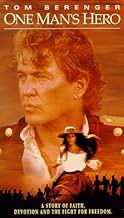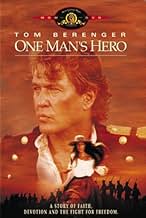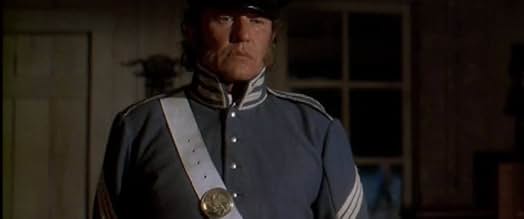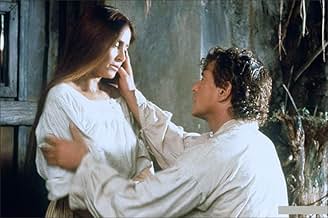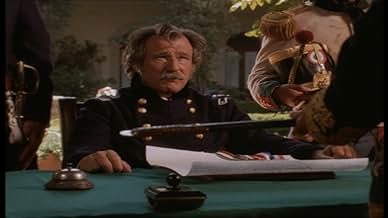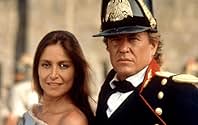NOTE IMDb
6,0/10
1,4 k
MA NOTE
Ajouter une intrigue dans votre langueJohn Riley, an Irish immigrant soldier recruited in the American army during the Mexican-American War faces anti-immigrant and anti-Catholic bigotry from his fellow servicemen and defects to... Tout lireJohn Riley, an Irish immigrant soldier recruited in the American army during the Mexican-American War faces anti-immigrant and anti-Catholic bigotry from his fellow servicemen and defects to the Mexican army.John Riley, an Irish immigrant soldier recruited in the American army during the Mexican-American War faces anti-immigrant and anti-Catholic bigotry from his fellow servicemen and defects to the Mexican army.
- Réalisation
- Scénario
- Casting principal
- Récompenses
- 3 nominations au total
Avis à la une
"One Man's Hero" is set in the 1840's , Mexico was embroiled in turmoil . Renegades and revolutionaries ruled the mountains and the central government was trying to regain control . The neighboring United States saw the opportunity to invade . Across the Atlantic Ocean a different battle raged , as Ireland lost half its population to the potato famine . Desperate and broken two million Irishmen sailed across to the United States . Enticed by the promise of citizenship , scores of young Catholic Irishmen joined the predominantly US Army. For most , it was their only choice . The Saint Patrick's Battalion (Spanish: Batallón de San Patricio, later reorganized as the Foreign Legion of Patricios), formed and led by John Riley, was a unit of 175 to several hundred (accounts vary) immigrants and expatriates of European descent who fought as part of the Mexican Army against the United States in the Mexican-American War of 1846-48. It is set in 1846 , the plot centers around John Riley (Tom Berenger) , an Irish immigrant soldier recruited in the American army during the Mexican-American War , being a sergeant in command of a battalion who are usually despised by the soldiers remaining . One day , John Riley and other Irishmen deserted to Mexico after in the U.S. Army during the Mexican-American War. As the motley bunch flee to Mexico , there they are assaulted and imprisoned by a Mexican guerrilla led by deserters (Joaquin De Almeida , Daniela Romo) opposite the Mexico government . Later on , Riley and his men choose to be soldiers for the Mexican Army , waging war the US invader . Riley then is commissioned as a Captain in the Mexican Army and fights with soldiers on both sides of the border.
It tells the little-known story of the "St. Patrick's Battalion" or "San Patricios," a group of mostly Irish, and other immigrants of the Catholic religion, who are mistreated , humiliated by US soldiers and encountering religious and ethnic prejudice . The script revolves around the personal story of John Riley, an Irishman who had been a Sergeant in the American Army . Here Tom Berenguer gives a good acting as the Irish sergeant who faces off anti-immigrant and anti-Catholic bigotry from his fellow servicemen and defects to the Mexican army , subsequently commanding an Irish battalion, as he leads his men in battle. He is well accompanied by a good cast, such as : Joaquin De Almeida as a rebel officer , Daniela Romo as a stubborn Guerrilla woman who falls for Riley , Mark Moses as an US upright Colonel , Stephen Toblowsky as a nasty officer , James Gammon as General Zachary Taylor , Patrick Bergin as General Scott , and a cameo by Prince Alberto de Monaco . It packs a colorful and evocative cinematography by Peter Wooley . And a rousing and thrilling musical score by Ernest Troost , shot on location in Durango , Puebla , Morelos, Mexico . Lavishly financed by Spanish/US/Mexican producers as Julio Fernandez , Jaime Comas Gil , Conrad and Lance Hool . The motion picture was well written , produced and directed by Lance Hool.
It is well based on facts , about Saint Patrick's Batalion , being composed primarily of Catholic Irish immigrants, the battalion also included Germans, Canadians, English, French, Italians, Poles, Scots, Spaniards, Swiss, and Mexicans, many of whom were also members of the Catholic Church. Most of the battalion's members had deserted or defected from the United States Army. The battalion served as an artillery unit for much of the war. Despite later being formally designated as two infantry companies, it still retained artillery pieces throughout the conflict. In many ways, the battalion acted as the sole Mexican counterbalance to the recent U.S. innovation of horse artillery. The San Patricios were responsible for the toughest battles encountered by the United States in its invasion of Mexico, with Ulysses S. Grant remarking that "Churubusco proved to be about the severest battle fought in the valley of Mexico".Disenfranchised Americans were in the ranks, including escaped slaves from the Southern United States. Only a few members of the Saint Patrick's Battalion were actual U.S. citizens. The Mexican government printed propaganda in different languages to entice immigrants in the U.S. Army to switch sides and offered incentives to foreigners who would enlist in its army including granting them citizenship, paying higher wages than the U.S. Army, and generous land grants. U.S. Army regiments from which members are known to have deserted include: the 1st Artillery, the 2nd Artillery, the 3rd Artillery, the 4th Artillery, the 2nd Dragoons, the 2nd Infantry, the 3rd Infantry, the 4th Infantry, the 5th Infantry, the 6th Infantry, the 7th Infantry, and the 8th Infantry.The San Patricios are honored in both Mexico and Ireland.The San Patricios captured by the U.S. Army were treated and punished as traitors for desertion in time of war. Seventy-two men were immediately charged with desertion by the Army.Two separate courts-martial were held, one at Tacubaya on 23 August, and another at San Ángel on 26 August. At neither of these trials were the men represented by lawyers nor were transcripts made of the proceedings. This lack of formal legal advice could account for the fact that several of the men claimed that drunkenness had led them to desert (a common defense in military trials at the time that sometimes led to lighter sentences), and others described how they were forced to join the Mexican Army in some form or another. The majority of the San Patricios either offered no defense or their defenses were not recorded. Wealthy Mexicans came to the San Patricios' defence at the trials, and members of Mexico's first families visited them in prison . There had strong sentences against the Irish soldiers . One soldier who claimed he was forced to fight by the Mexicans after he was captured by them, and who subsequently refused to do so, was sentenced to death by firing squad instead of hanging, along with another who was found not to have officially joined the Mexican Army. Most of the convicted San Patricios were sentenced to death by hanging: 30 from the Tacubaya trial and 18 from San Ángel. The rationale was that they had entered Mexican military service following the declaration of war. Execution by hanging was in violation of the contemporary Articles of War, which stipulated that the penalty for desertion and/or defecting to the enemy during a time of war was death by firing squad, regardless of the circumstances. Hanging was reserved only for spies (without uniform) and for "atrocities against civilians", neither of which activities were among the charges brought against any members of the Saint Patrick's Battalion. Although more than 9,000 U.S. soldiers deserted the army during the Mexican-American War, only the San Patricios (who unlike almost all other deserters had also fought against the United States) were punished by hanging. Those soldiers who had left military service before the official declaration of war on Mexico (Riley among them) were sentenced to "... receive 50 lashes on their bare backs, to be branded with the letter 'D' for deserter, and to wear iron yokes around their necks for the duration of the war . In all, 50 Saint Patrick's Battalion members were officially executed by the U.S. Army. Collectively, this was the largest mass execution in United States history-the hanging of 38 Sioux at the conclusion of the Dakota War of 1862 appears to be the largest execution by hanging at a single event. En masse executions for treason took place at three separate locations on three separate dates; 16 were executed on 10 September 1847 at San Ángel, four were executed the following day at the village of Mixcoac on 11 September, and 30 were hanged at Chapultepec.
It tells the little-known story of the "St. Patrick's Battalion" or "San Patricios," a group of mostly Irish, and other immigrants of the Catholic religion, who are mistreated , humiliated by US soldiers and encountering religious and ethnic prejudice . The script revolves around the personal story of John Riley, an Irishman who had been a Sergeant in the American Army . Here Tom Berenguer gives a good acting as the Irish sergeant who faces off anti-immigrant and anti-Catholic bigotry from his fellow servicemen and defects to the Mexican army , subsequently commanding an Irish battalion, as he leads his men in battle. He is well accompanied by a good cast, such as : Joaquin De Almeida as a rebel officer , Daniela Romo as a stubborn Guerrilla woman who falls for Riley , Mark Moses as an US upright Colonel , Stephen Toblowsky as a nasty officer , James Gammon as General Zachary Taylor , Patrick Bergin as General Scott , and a cameo by Prince Alberto de Monaco . It packs a colorful and evocative cinematography by Peter Wooley . And a rousing and thrilling musical score by Ernest Troost , shot on location in Durango , Puebla , Morelos, Mexico . Lavishly financed by Spanish/US/Mexican producers as Julio Fernandez , Jaime Comas Gil , Conrad and Lance Hool . The motion picture was well written , produced and directed by Lance Hool.
It is well based on facts , about Saint Patrick's Batalion , being composed primarily of Catholic Irish immigrants, the battalion also included Germans, Canadians, English, French, Italians, Poles, Scots, Spaniards, Swiss, and Mexicans, many of whom were also members of the Catholic Church. Most of the battalion's members had deserted or defected from the United States Army. The battalion served as an artillery unit for much of the war. Despite later being formally designated as two infantry companies, it still retained artillery pieces throughout the conflict. In many ways, the battalion acted as the sole Mexican counterbalance to the recent U.S. innovation of horse artillery. The San Patricios were responsible for the toughest battles encountered by the United States in its invasion of Mexico, with Ulysses S. Grant remarking that "Churubusco proved to be about the severest battle fought in the valley of Mexico".Disenfranchised Americans were in the ranks, including escaped slaves from the Southern United States. Only a few members of the Saint Patrick's Battalion were actual U.S. citizens. The Mexican government printed propaganda in different languages to entice immigrants in the U.S. Army to switch sides and offered incentives to foreigners who would enlist in its army including granting them citizenship, paying higher wages than the U.S. Army, and generous land grants. U.S. Army regiments from which members are known to have deserted include: the 1st Artillery, the 2nd Artillery, the 3rd Artillery, the 4th Artillery, the 2nd Dragoons, the 2nd Infantry, the 3rd Infantry, the 4th Infantry, the 5th Infantry, the 6th Infantry, the 7th Infantry, and the 8th Infantry.The San Patricios are honored in both Mexico and Ireland.The San Patricios captured by the U.S. Army were treated and punished as traitors for desertion in time of war. Seventy-two men were immediately charged with desertion by the Army.Two separate courts-martial were held, one at Tacubaya on 23 August, and another at San Ángel on 26 August. At neither of these trials were the men represented by lawyers nor were transcripts made of the proceedings. This lack of formal legal advice could account for the fact that several of the men claimed that drunkenness had led them to desert (a common defense in military trials at the time that sometimes led to lighter sentences), and others described how they were forced to join the Mexican Army in some form or another. The majority of the San Patricios either offered no defense or their defenses were not recorded. Wealthy Mexicans came to the San Patricios' defence at the trials, and members of Mexico's first families visited them in prison . There had strong sentences against the Irish soldiers . One soldier who claimed he was forced to fight by the Mexicans after he was captured by them, and who subsequently refused to do so, was sentenced to death by firing squad instead of hanging, along with another who was found not to have officially joined the Mexican Army. Most of the convicted San Patricios were sentenced to death by hanging: 30 from the Tacubaya trial and 18 from San Ángel. The rationale was that they had entered Mexican military service following the declaration of war. Execution by hanging was in violation of the contemporary Articles of War, which stipulated that the penalty for desertion and/or defecting to the enemy during a time of war was death by firing squad, regardless of the circumstances. Hanging was reserved only for spies (without uniform) and for "atrocities against civilians", neither of which activities were among the charges brought against any members of the Saint Patrick's Battalion. Although more than 9,000 U.S. soldiers deserted the army during the Mexican-American War, only the San Patricios (who unlike almost all other deserters had also fought against the United States) were punished by hanging. Those soldiers who had left military service before the official declaration of war on Mexico (Riley among them) were sentenced to "... receive 50 lashes on their bare backs, to be branded with the letter 'D' for deserter, and to wear iron yokes around their necks for the duration of the war . In all, 50 Saint Patrick's Battalion members were officially executed by the U.S. Army. Collectively, this was the largest mass execution in United States history-the hanging of 38 Sioux at the conclusion of the Dakota War of 1862 appears to be the largest execution by hanging at a single event. En masse executions for treason took place at three separate locations on three separate dates; 16 were executed on 10 September 1847 at San Ángel, four were executed the following day at the village of Mixcoac on 11 September, and 30 were hanged at Chapultepec.
I was fortunate to attend the premiere. Now I am trying to find out when OMH will be released to the SF Bay Area so that I can tell my friends to be sure to see it.
I am very familiar with writer Michael Hogan's work in both his The Irish Soldiers of Mexico and Molly Malone and the San Patricios. Michael is a superb poet too. I happen to know too that he served as a consultant on the troop movements, the uniforms, the flags etc. when the Hools were filming in Durango.
The film depicts a little known episode in the U.S.'s quest to dominate the northern hemisphere. We know that this quest was successful, but we also know that the price in blood was much higher than any of the proponents of Manifest Destiny ever dreamed.
The acting is superb. I especially liked Joaquim Alameda for his portrayal of a renegade patriot. I think there is another great story there that perhaps the Hools should do. What did happen to him? Did he spawn Zapata?
Finally, the score, the scenery, and the battle scenes were really well done. Pity the poor lads who had to pay even more than the price named in the Military Code of Justice. That was a shame, but we must remember their memory will live on forever. Even more so now that Lance and Conrad Hool have immortalized them on film.
I am very familiar with writer Michael Hogan's work in both his The Irish Soldiers of Mexico and Molly Malone and the San Patricios. Michael is a superb poet too. I happen to know too that he served as a consultant on the troop movements, the uniforms, the flags etc. when the Hools were filming in Durango.
The film depicts a little known episode in the U.S.'s quest to dominate the northern hemisphere. We know that this quest was successful, but we also know that the price in blood was much higher than any of the proponents of Manifest Destiny ever dreamed.
The acting is superb. I especially liked Joaquim Alameda for his portrayal of a renegade patriot. I think there is another great story there that perhaps the Hools should do. What did happen to him? Did he spawn Zapata?
Finally, the score, the scenery, and the battle scenes were really well done. Pity the poor lads who had to pay even more than the price named in the Military Code of Justice. That was a shame, but we must remember their memory will live on forever. Even more so now that Lance and Conrad Hool have immortalized them on film.
An epic, slow grinding war story of source accounts with romance, faith and loyalty streaming through. I don't know how true it is to the facts, but you couldn't help but admire its powerful scope and sound performances led by Tom Berenger. Irishman John Riley leads his fellow countrymen who desert to Mexico just before the American-Mexican war after encountering religious and ethnic prejudice in the US cavalry. While holding up in Mexico, war is ignited and the men form the St Patrick's brigade where they become allies with the Mexicans. The story shows how much in common these two sides shared in their viewpoint of freedom, which the Irish men saw when they lived and fought side by side with the Mexicans. They kept fighting on, despite the odds being stacked up against them. The war scenes are dramatically staged with strategic precision and bravery, as it becomes a stirring display of chemistry and spirit between the cast. The characters do provide good insight and form lasting impressions, making the entire ordeal even more effective when they meet their fate. Joaquim de Almeida is perfectly strong willed as a Mexican outlaw and Daniela Roma as the Mexican lady caught in a love triangle.
"One man's hero. Is another man's traitor I reckon sir."
"One man's hero. Is another man's traitor I reckon sir."
John Riley did indeed lead Irish deserters for Mexico in the war. The Irish were ill-used by Nativist officers who didn't like 'croppies.' Protestant America was feeling threatened by the huge influx of Catholic Irish flooding into the US from famine-struck Ireland. Few troops have been given more reason to desert. However, the movie tells it all wrong. Riley wasn't a sergeant and didn't plan to return after getting his men to safety. He was a private who swam the Rio Grande a month before the war was declared. He responded to 'desertion leaflets' that the Mexicans had sneaked into American Camps. No US army ever had higher desertion rates.
The treatment of Winfield Scott is rather harsh. Riley was actually sentenced to hang with virtually all of his men but it was Scott who commuted his sentence (the still harsh 50 lashes and branding), along with that of more than a score of his men. This infuriated Scott's Nativist officers.
Riley remained in the Mexican Army after the war for a year or so and almost certainly returned to Ireland thereafter. Also, he was a young fellow, about thirty, which made it hard to accept Tom in the role. Another thing that was irritating is that there is a list of the men who served under Riley and it is amazing that the screenwriter decided to create fictional replacements instead. Why? Also, one must not forget that most Irish, despite poor treatment by prejudiced officers, did not desert. Who was more heroic, those who deserted or those who didn't?
All in all, a disappointment. However, it is one of the very few films that deals with the Mexican American War, and for that I commend it.
The treatment of Winfield Scott is rather harsh. Riley was actually sentenced to hang with virtually all of his men but it was Scott who commuted his sentence (the still harsh 50 lashes and branding), along with that of more than a score of his men. This infuriated Scott's Nativist officers.
Riley remained in the Mexican Army after the war for a year or so and almost certainly returned to Ireland thereafter. Also, he was a young fellow, about thirty, which made it hard to accept Tom in the role. Another thing that was irritating is that there is a list of the men who served under Riley and it is amazing that the screenwriter decided to create fictional replacements instead. Why? Also, one must not forget that most Irish, despite poor treatment by prejudiced officers, did not desert. Who was more heroic, those who deserted or those who didn't?
All in all, a disappointment. However, it is one of the very few films that deals with the Mexican American War, and for that I commend it.
It is a movie...so I expect there to be embellishments--in plot, especially, amongst other things. The acting? Well, I am not a movie critic...it was passable, not great, not horrible--most of the acting did seem flat and non-dimentional, however, you are getting just a glimpse of a few (a very few) of the major characters. What I do like overall, is, the fact that someone attempted to make a movie about this era of American History, especially, due to its pivotal role that the Mexican-American War would play in the years following the conclusion.
On the historical facts of the movie, well, it has errors: for example, the Americans seem to "out-number" the Mexican forces--and as we all know the average ratio was between 3:2 and 3:1, in favor of the Mexican Army, in all the battles--which could have made the movie more spectacular--for the "bad" Americans--if they can be called that--something that was latent but not overt. As others have pointed out, it also does have a "Mexican" bias, but this is due to the arrangement of the plot of the movie...concerning the San Patricios Companies of Foreigners. I personally thought the biases of the "named" characters (at least the Americans) were "historically" correct--despite any gaffes in acting. Zachary Taylor (James Gammon) had his "damn the consequences" attitude, and Winfield Scott (Patrick Bergen) was also "true" to the history. The "Anti-Catholic" (not just Anti-Irish) sentiment as portrayed by the junior officers and non-comms in front of the Colonel of the 5th US Infantry Regiment, is also in line with the time.
It is a shame that they could not work in more of the major characters (and a few of the Civil War Generals--in their baptism of fire). We see Scott, Taylor and Harney; It would have been nice to see others like Santa Anna, David Twiggs, William Worth, etc. as well as maybe Jackson as an Artillery Lieutenant moving his guns forward at Churubusco to take on the San Patrico batteries or Grant moving his men of the 4th Infantry forward, or even Lee reconoitering a position. However nice this may have been, it was extraneous to telling the movie-maker's story, and it was not to be.
Not every movie can be a "Gettysburg" calibre movie...but considering the "attention span" of my fellow countrymen (most would not endure a 4 hour movie--let alone the subject matter), this movie trys to be entertaining, as well as, historically "honest". I say, "bravo".
On the historical facts of the movie, well, it has errors: for example, the Americans seem to "out-number" the Mexican forces--and as we all know the average ratio was between 3:2 and 3:1, in favor of the Mexican Army, in all the battles--which could have made the movie more spectacular--for the "bad" Americans--if they can be called that--something that was latent but not overt. As others have pointed out, it also does have a "Mexican" bias, but this is due to the arrangement of the plot of the movie...concerning the San Patricios Companies of Foreigners. I personally thought the biases of the "named" characters (at least the Americans) were "historically" correct--despite any gaffes in acting. Zachary Taylor (James Gammon) had his "damn the consequences" attitude, and Winfield Scott (Patrick Bergen) was also "true" to the history. The "Anti-Catholic" (not just Anti-Irish) sentiment as portrayed by the junior officers and non-comms in front of the Colonel of the 5th US Infantry Regiment, is also in line with the time.
It is a shame that they could not work in more of the major characters (and a few of the Civil War Generals--in their baptism of fire). We see Scott, Taylor and Harney; It would have been nice to see others like Santa Anna, David Twiggs, William Worth, etc. as well as maybe Jackson as an Artillery Lieutenant moving his guns forward at Churubusco to take on the San Patrico batteries or Grant moving his men of the 4th Infantry forward, or even Lee reconoitering a position. However nice this may have been, it was extraneous to telling the movie-maker's story, and it was not to be.
Not every movie can be a "Gettysburg" calibre movie...but considering the "attention span" of my fellow countrymen (most would not endure a 4 hour movie--let alone the subject matter), this movie trys to be entertaining, as well as, historically "honest". I say, "bravo".
Le saviez-vous
- AnecdotesAnnually, the town of Clifden, Connemara, Ireland flies the Mexican flag, in honor of John Riley, born in the town, and the men of the San Patricio's Battalion.
- GaffesThere are a number of geographical and historical errors in this film, including some scenes in the battle of Churubusco (the last battle in the movie).
Meilleurs choix
Connectez-vous pour évaluer et suivre la liste de favoris afin de recevoir des recommandations personnalisées
- How long is One Man's Hero?Alimenté par Alexa
Détails
- Date de sortie
- Pays d’origine
- Langues
- Aussi connu sous le nom de
- Herois sense pàtria
- Lieux de tournage
- Sierra de Organos, Sombrerete, Zacatecas, Mexique(exterior scenes)
- Société de production
- Voir plus de crédits d'entreprise sur IMDbPro
Box-office
- Budget
- 11 350 000 $US (estimé)
- Montant brut aux États-Unis et au Canada
- 240 067 $US
- Week-end de sortie aux États-Unis et au Canada
- 108 567 $US
- 26 sept. 1999
- Montant brut mondial
- 240 067 $US
- Durée2 heures 1 minute
- Couleur
- Mixage
- Rapport de forme
- 2.35 : 1
Contribuer à cette page
Suggérer une modification ou ajouter du contenu manquant

Lacune principale
By what name was One Man's Hero (1999) officially released in India in English?
Répondre

